

 The Accurate Reloading Forums
The Accurate Reloading Forums  THE ACCURATE RELOADING.COM FORUMS
THE ACCURATE RELOADING.COM FORUMS  Hunting
Hunting  Hunting Reports - Rest Of The World
Hunting Reports - Rest Of The World  Dall's Sheep & Caribou - NWT 2006 (+ Mount Pictures)
Dall's Sheep & Caribou - NWT 2006 (+ Mount Pictures)Go  | New  | Find  | Notify  | Tools  | Reply  |  |
| one of us |
DALL'S SHEEP & MOUNTAIN CARIBOU HUNT SUMMARY Date of Hunt: August 5-14, 2006 Location: WMU #3, Mackenzie Mountains, Northwest Territories, Canada Animals Harvested: Dall's Sheep (Ovis dalli dalli) & Mountain Caribou Animals Seen But Not Hunted: Grizzly Bear, Moose, Wolf, Golden Eagle, Ptarmigan, Porcupine, Pika (Rock Rabbit), Ground Squirrel Outfitter: Stan Simpson, Ram Head Outfitters Email: ramheadoutfitters@hotmail.com Phone: 780-848-7578 Website: Ram Head Outfitters Website Guides: Carson Nutting, Jayme Hunter & Meghan Simpson; Wrangler Tim Erickson Hunt Cost: $14,400 for Dall (increasing for 07) + $2,400 for Caribou Licensing & Misc Notable Costs: $1000 Air Charter to/from Norman Wells & Camp + 7% Canadian GST ~$700 + $400 Export Fees + $190 License Fees w/Wolf & Fishing License Commercial Flights: Air Canada to Edmonton, Canadian North to Norman Wells BACKGROUND My first hunt for Dall Sheep took place in 2002, in the rugged [but beautiful] Wrangell Mountains of Alaska. It was a combination hunt and although I was not successful on harvesting a sheep, we did see sheep and had a wonderful adventure. A few pictures of this trip are posted at: CLICK HERE Although I thought I was in decent condition, the Wrangell's pretty much kicked my butt. I vowed to return one day to hunt the mountains in true “Sheep Shapeâ€. Years passed, and it was not until Dec 2005 that I thought seriously about booking another sheep hunt. While lifting a heavy object, I sustained a "distal bicep tendon rupture", a rare injury where basically the bicep muscle on my left arm tore completely from the bone in my forearm. Mostly common with weightlifters or football players, it was repairable although the doc's were not too optimistic regarding my ability to regain full motion and strength. As an incentive to rehab quickly, I began to research reputable sheep outfitters in the Yukon and Northwest Territories. Although more expensive then Alaska, it is fairly easy to identify quality operators as the number of companies are somewhat fixed and information is readily available. For example, there are only (8) operators allowed to hunt Dall sheep in all of the Northwest Territories, which means that these companies are very visible via the various sheep hunting organizations and magazines, and there are literally hundreds of references available. Operators are given long-term rights to huge areas of land that see little or no resident pressure (a situation I experienced in the Wrangell Mtns), and success rates are very high. The problem, however, is that the top outfitters sell out well in advance, and the majority that I contacted were fully booked for the 2006 season. However, Stan Simpson had a cancellation for the third hunt of the season, August 5-14th, which was an ideal time of the year. Caribou would be open, and although they would still be in velvet, their antlers would be hard and fully developed. Many conversations later, in January, I sent off my somewhat considerable deposit. Considered a "backpack hunt", the plan was to take horses (or river boat or bush plane at Stan's discretion) to the drop-off point from where my guide and I would backpack into the mountains for ~3-4 days at a time. If we were not successful on a sheep, I would have a satellite phone and call Stan, who would arrange to get us back to one of the main sheep camp, feed us, then take us back out to a different area to try again. TRAINING & CONDITIONING Anticipation and preparation are arguably the most enjoyable aspects of a sheep hunt. As is often said, being in good condition not only increases the probability of success, but adds to the enjoyment of the hunt for the participant...and those around him. In 2005, I did a lot of road cycling, logging some 2500 miles in nine months. This, combined with 3 to 4 workouts per week in the gym gave me an excellent foundation from which to start. However, with the injury to my arm, my workout options for the first two months were limited, and consisted of lifting with my good arm and riding indoors on a computerized cycle trainer (a CompuTrainer), focusing on things such as V02 max, watts and cadence. I also started using a stepper, at first with just body weight, then with a weighted backpack. Things progressed well, after 6-weeks the sling came off and much to the surprise of my orthopedic surgeon, I had 95%+ arm extension and wrist supination. This cut my rehab down from 2-3 months to literally five visits during which time I was able to carefully start lifting weights again. It was about then that I finally decided on which backpack and boots to purchase. Being a lifelong "gym rat", the temptation was to continue using the stepper while adding lots of lunges, squats and calf raises to the routine, and consider myself "ready". Thankfully, one trip to a local State Park convinced me otherwise. Thus began my backpacking obsession. Initially weight was modest, and gradually increased to the point in May/June where I was comfortably carrying 40-45lbs for two to three hour hikes including hills. I maintain a detailed training log that includes caloric intake and activities performed, which was very helpful in tracking my progress and staying on course. The plan was to maintain from eight weeks out up until the hunt, however, concern over my ability to handle "pack-in loads" (50lbs+) got the better of me. After a few weeks with ~65lbs (pack included), I began to experience pain with my knees, especially when descending, but even on modest changes in ground contour. I doubled the dosages of fish oil and glucosamine/chondroitin, which I had been taking since my bicep tear, but only after backing off the weight to a more manageable amount did the soreness go away. HUNTING AREA The eight hunting concessions in the Mackenzie Mountains of the NWT are huge, and Stan's is some 15,000 square miles, or 9.5 million acres in size. There are no local residents and virtually zero hunting pressure. The terrain ranges from dense jungle-like pine to rolling mountains and tundra to rugged rocky cliffs and peaks in the higher elevations (~9000ft). Our base camp was at/about 4500ft, and we climbed to perhaps 7500ft. One of the attractive aspects of the hunt is the remoteness of the area, accessible only via bush plane or chopper ride from Norman Wells. Stan's concession is unique in that it runs north to south and into the lower elevations, allowing him to offer moose and goat hunts, in addition to the Dall's sheep and mountain caribou. I hunted Stan Simpson's unit - S/OT/03  HUNTING METHODS Stan offers horseback and backpack hunts. The usage of helicopters is a hot topic, with people's opinions strong either for or against its merits. For me, it is not so cut-and-dry. Arguing for the usage is the rational that it allows outfitters to evenly distribute the hunting pressure throughout the entire concession, versus hammering the same area year after year. Stan has operated in this area for the past 25 years, and he knows it very well and finding sheep is generally not a problem. However, getting hunters to them is, as not all areas are available by other means (float or bush plane, horses or river raft). Many are of course, and this is the typical way that hunters are transported to their hunting area after being first flown to one of three main "sheep camps". From what I observed first-hand, with Stan these are not "drop off and shoot" hunts (which IMO are unacceptable regardless of the justification), and still quite physical requiring spike camping and several days of hiking and climbing. In some cases they can be more difficult then other type of hunts, as once dropped off, the guide and hunter are on their own (unless moved by the outfitter). In fact, some backpack hunts begin in this manner, using the chopper only to get into an area where one can begin hunting. One hunter this season gave up and went home after just a few days, even with the chopper it was too difficult for him. I believe this to be a prudent and reasonable use of the helicopter. Those against using choppers believe that those otherwise inaccessible sheep should indeed die of old age, or be killed by hunters that have the ability and tenacity to venture into the remotest and most difficult areas. Part of me agrees with this. For mature hunters, who are most often the ones that can afford/justify a hunt such as this, using a chopper might be the only way for them to get high and into an area to get a sheep. And who's to say they are any less deserving then somebody who can walk vertically all day long. Regardless of your opinion, and generally speaking, I think this demonstrates a dangerous trend in guided hunting (North America, Africa or elsewhere). The higher-end operators need to cater to, and have come to expect a certain class of hunter. The hunts costs increase, which means that only a select group of people can afford the hunt, and the cycle perpetuates itself. As the guides said, "We have 2-3 days to get hunters on a sheep, after that, we lose them". The operators and guides feel the pressure to get the hunters their sheep in the shortest amount of time possible, noting that the majority of successful hunters go home early. All this leads to what can feel like a "hurried" hunt for guys like me who value the EXPERIENCE and not just the TROPHY. THE HUNT On the flight from Edmonton to Norman Wells, I sat across from another hunter who was also headed in for a backpack hunt with Stan. We talked much of the flight and seemed to have similar outlooks, expectations and physical abilities. Which was a dang good thing, as it turned out that Chance and I would be hunting partners!!! Stan informed Chance and I that there had been a change of plans, and that he had a remote horse camp all setup in a "valley that had not been hunted for years". A chopper flight would be arranged to take us to camp, allowing us to start hunting first-thing in the morning (no day spent trailing in). Good rams were spotted in the valley, and caribou could be found in the hills above camp. Having been on a multiple guided trips, I have learned to roll with the punches and allow situations to develop, then sort it out. Thankfully, Chance shares my positive outlook and we did not dwell on this change in scope, nor let it spoil our hunt in any way. Gear in the back of Stan's pickup 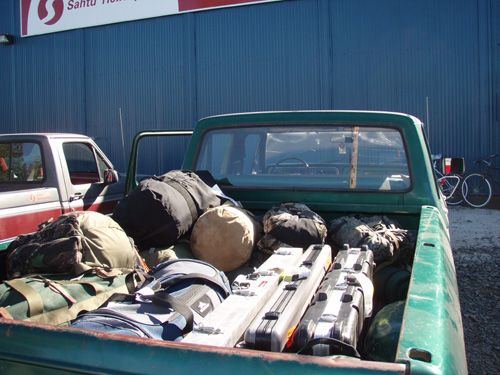 Me with pilot Gee 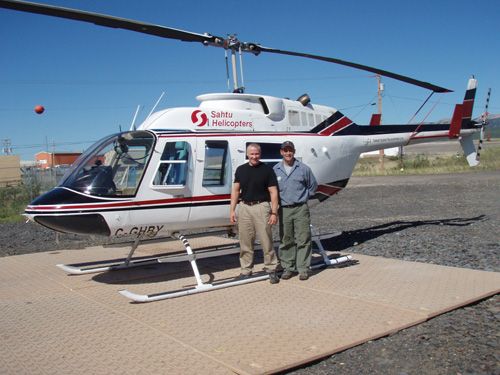 Gee, our pilot pictured above, is a terrific guy. A Frenchman living in Norman Wells, Gee is a fellow hunter (he shot a sheep that he had been after for 3 years while I was there) and an excellent conversationalist. Dang good pilot too. We were delayed about an hour waiting for the chopper, as Gee had to recover a body of a young man that had drowned along with two others a few weeks ago while boating in the Mackenzie River. I understand that the family of the victims were further traumatized when the plane carrying five family members and friends crashed when returning to Fort Good Hope after a funeral for two of the young men. Just a terrible shame. The ~45 minute chopper flight into camp was a thrill, and neither Chance nor I had ever been in a helicopter before. The rush was awesome when flying along a plateau at 120 mph and having the bottom drop out as the chopper clears the cliffs. We did not see any sheep on the way in, noting we took the most direct flight straight to camp. After dropping us off, Gee was picking up another hunter in another unit that had finished his hunt, and was looking to get back to Norman Wells. Job trailers waiting for the ground to freeze, oil/gas and minerals are big business in the NWT 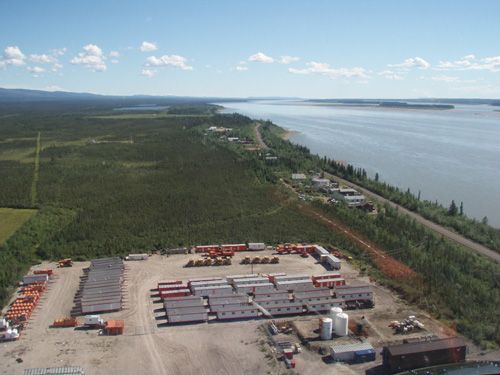 Entering the Mackenzie Mountains 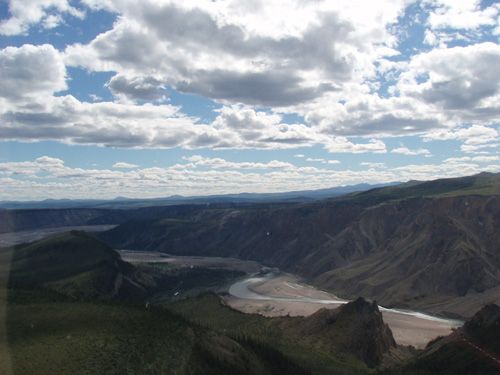 Setting down the chopper at "Horse Camp" 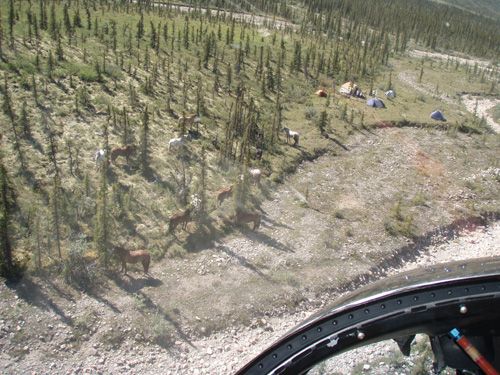 The neat thing is that at this time of the year there is about 20 hours of light, and you can opt to hunt anytime between say 5am and 12pm. Day-1 we were up and out early, "bush-busting" with the horses for about 3hrs to reach a valley where the guides had seen sheep from the air. Along the way we saw cow moose (the bulls in velvet were still up high due to the bugs), bull caribou and a young grizzly which was my first and a real treat. Unfortunately, on the ride back to camp, I developed pain in my knees which I have come to learn is quite common among recreational riders. Chance experienced similar issues, although his ~35 year old knees healed up quicker than mine. I have ridden before and even took some lessons with my wife without any problems, so perhaps this was caused by the stirrups being too high and my "motocross riding style" with too much weight on the knees and not enough on the saddle, and/or too-much-too-soon. Whatever the cause, it was fine hiking, but was painful when riding. Sunrise Day-1 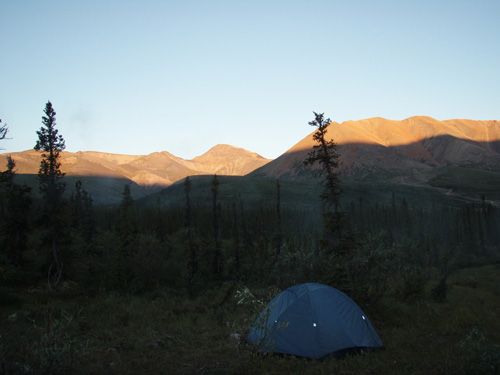 Pictures from the ride through the valley 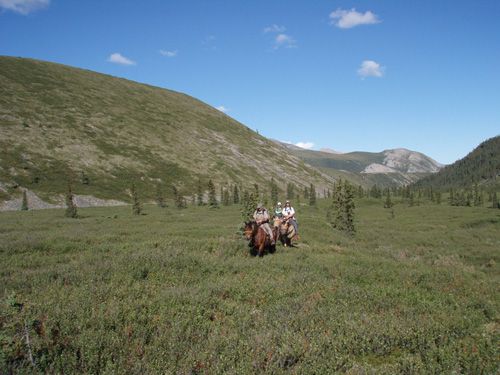  Ewes & lambs on the mountain (without zoom then through the spotting scope)  Although we did not see any rams with the ewes (I really didn't expect to), on the way back and about 1.5hrs from camp, we found a band of three males. They were about 1/3 the way up the side of a mountain, feeding just above tree line. We glassed them for a while, and Carson determined that two were legal and shooters, one with sweeping, wide, thick horns, and the other basically a slightly smaller version. Spirits were high on the way back to camp, and plans were made to return first thing in the morning and see if we couldn't get on them. The next morning we took the horses to the hill across from where the rams had been seen the night before, hoping that they moved to an area that would allow us to more easily stalk them. Instead, we found the band of rams at the very top of the mountain (the far-right peak on the picture below). We watched the group for a few hours as they moved across the top. At one point they looked as though they were going to drop down the closest ridge, however, for reasons unbeknownst to us, the bigger ram abruptly stopped and looked in our direction, turned, and ran back up to the top. I still wonder what might have provoked this, possibly a wolf or bear below us, or maybe he saw our movement w/their reported 8x eyes, as we were a large group (5 people with horses plus a pack horse). What this meant is that if we wanted to get after them, we were going to have to get to the top. And we needed to make the decision quickly, as even though it was only 2pm and we still had some ten hours of light left, it was going to require time to get up the mountain - and back down again. Mountain where the rams were spotted 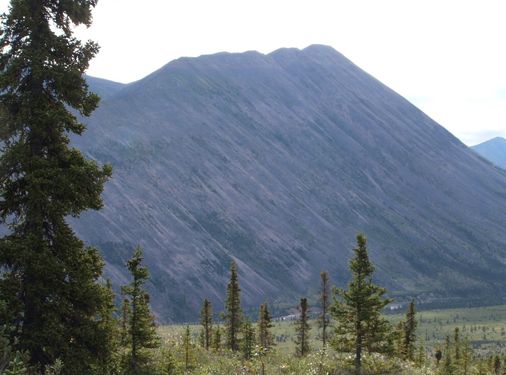 We talked over the options, which were to sneak up the drainage on the left-hand side of the mountain and try to get them from above, or wait until tomorrow to see if they were in a better position. We opted to go for it, and made our way down the hill to the cliff overlooking the river separating us from the mountain. We had a few sprinkles in the morning, but as we tied the horses the skies opened up, clouds moving towards us from over top of the mountain as if trying to chase us away from a forbidden lair. We put on our rain gear and slid down the steep bank. As we crossed the shallow river and started our ascent through the willows, the rain increased in intensity and thunder boomed overhead. Lighting cracked close by, which spooked Carson (who is afraid of lightning) into a full gallop up the hill. I did my best to keep up, but shredded by rain pants in the process. Fortunately the storm passed, but it was a surreal and exciting start to what would become a very long day. We climbed for several hours up the drainage, stopping from time to time to glass and catch our breath. As we followed the mountain stream bed, water was not a problem. Much of the early climb was technical, and required hopping from one rounded rock to another. It took me a bit of time to become comfortable with this, expecting the boulders to shift beneath my weight. They were, however, amazingly stable and I could move briskly as long as I picked the right path. I am glad to say that I did not fall or twist an ankle the entire trip, much of which is due to the Lowa's, which were really in their element. And all the training was beginning to pay off, as at 42 years old, I was exactly double the age of the oldest guide. Chance did great, due to his exceptional coordination, endurance and determination. About halfway up, we spotted the sheep at the top of the basin, which was GREAT news. They had made their way around the mountain to a bowl where they obviously felt comfortable. Things were coming together, but we would have no choice but to head straight for them, zigzagging as best we could to try to stay out of their direct line of sight and moving when they fed or looked another way. At one point, the big sheep laid down, looking straight down the valley. I wondered how spooky these sheep really were. We stayed pinned for a while, and attempted to climb up the side but when we got to the top we realized that the angle was bad and we had to retreat. As we neared the top, the chute narrowed into an eerie passageway, and the mountain stream increased in intensity and noise. At the very top, the round boulders were replaced with loose rock and green and white patches of spongy tundra, which again was surprisingly stable under foot. However, the clock was ticking, and by the time we got to within ~1000 yards, it was already around 9pm. Our group taking a short break on our way up the mountain 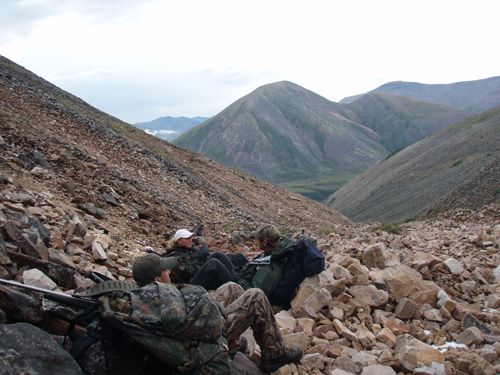 Carson leading the charge, bowl with sheep just ahead! 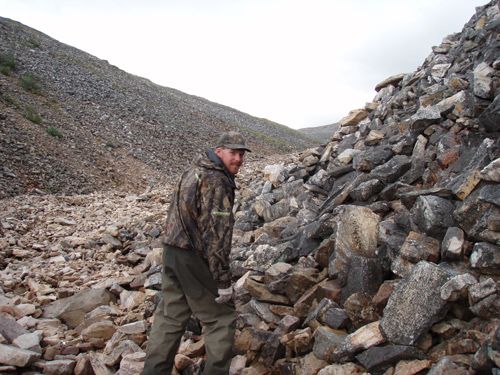 The mountains are terribly deceiving, and it never ceases to amaze me how long it takes to cover what appears to be a modest distance. As we closed in, Carson asked the obvious question, "Who is going to shoot first?". Two long-time hunting buddies would have likely worked this out ahead of time, but Chance and I had just met and frankly neither one of us wanted to approach this subject before we had to. Chance said I should shoot first, and I said he should. Chance was more convincing! There were now four rams. The biggest one was indeed the leader and the most mature ram, followed by another that looked close in size but lacking the width and mass of the older one, perhaps a younger brother. The third was a young half-curl ram. The fourth sheep, which we had not seen the night before, was well-broomed and hard to get a good look at as he remained on the periphery of the group. When we finally got in position, Carson glassed them using his Leica Geovid Rangefinder Binoculars. The big ram had disappeared, and was possibly behind a ridge or he had gone over the top of the mountain. Ram #2 was ranged to be just 190-yards away. As my primary goal was for an old sheep, I asked Carson twice "Is he good enough"", to which he replied both times, "He's your ram.". After a long and challenging climb and a near-perfect stalk, I was not going to argue, and dropped the ram as he began to move up the basin and away from us. After two trips to the mountains, I had my first Dall sheep! We high-fived and began to celebrate, but it was cut short when Meghan and Jayme both quietly yelled "THERE'S THE OTHER RAM!!!". Actually, two rams had appeared out of nowhere to see what all the commotion was about, with the big guy right at the very top of the mountain looking down at us. They very likely had never been hunted, and may just have assumed that the noise was more thunder. Excitement and chaos followed, as Chance and Jayme confirmed that he was our other shooter, and Chance got himself into position to take what was determined by the Leica's to be a very long shot. 550 yards to be exact. Chance does a lot of long-range varmint shooting at his home in Texas, and it was about to pay off for him, as he made a perfect heart-lung shot. The big ram just absolutely dropped where he stood - and the real celebration started. Three VERY happy guides: Meghan, Carson & Jayme 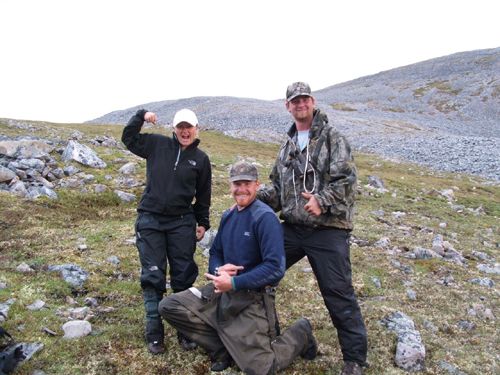 Me with my Dall's sheep & Kimber 8400 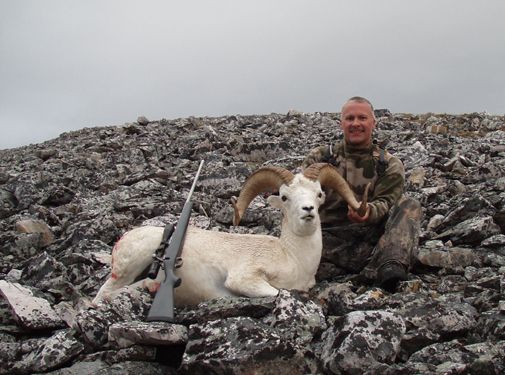 Guide Carson with my ram (now this is how to hold a sheep for picts!) 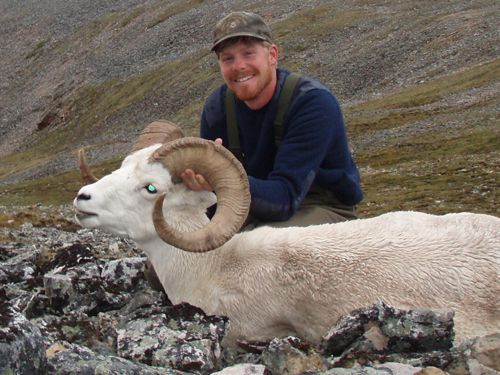 Chance with his awesome 37.5 inch, 13 year old Dall's sheep - way to go Chance!!! 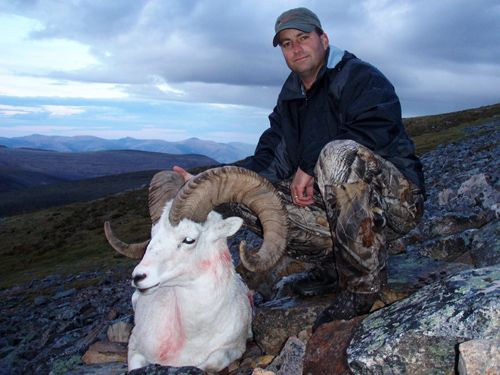 We took pictures of my sheep, but by the time we made it up to Chance's ram, light was fading fast. Carson stayed to cape and cut up Chance's sheep, while Jayme and I dropped back down to take care of mine. When we were done, it was 1am, and dark. As if in a final tribute to the slain monarchs of the mountain, the Northern Lights danced over our heads. Looking down the mountain before our descent 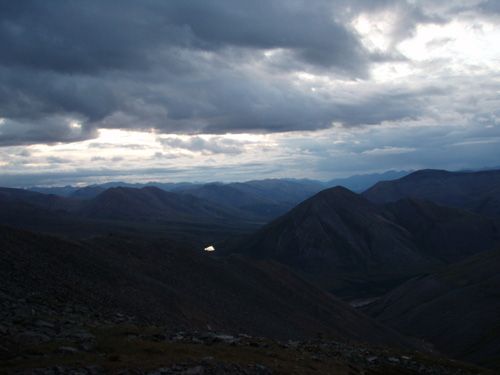 The descent was arguably more difficult then the way up, and without headlamps, it was hard to see. We made good time and proceeded without incident despite some rain and slippery conditions, but around 3:30am and just before the most technical (and darkest) part of the mountain, I convinced the guys that we should stop and rest until sun-up which was in a few short hours. Carson lit what he called a "Northwest Territories Candle" (a pine tree) which we huddled around to stay warm. We cooked some of the sweet, delicious sheep meat over the coals, something that I really had my heart set on. Exhausted, I slept under a plastic tarp as Meghan, Jayme and Carson talked, laughed, and enjoyed the here-and-now, before catching a few winks themselves. "Siwashing" on the Mountain  With renewed energy, around 6am, we continued on our way down. The river was a good bit higher and swifter, and I took some water in over the top of my boots. However, with the horses in sight and sheep in the packs, it mattered little. We hit camp at 9am, just about 24 hours from when we had left. We ate a big breakfast before heading to the tents for some much needed sleep. Chance and I were the first to stir in the early afternoon, and the rest of the day (day-4) was spent relaxing, reflecting and messing around camp. Jayme caping my sheep, with Meghan's cool dog Trixie standing guard 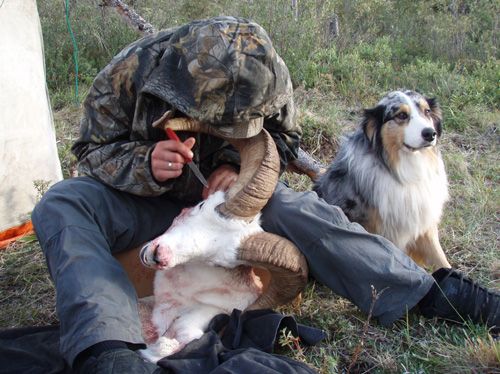 My hard-earned prize 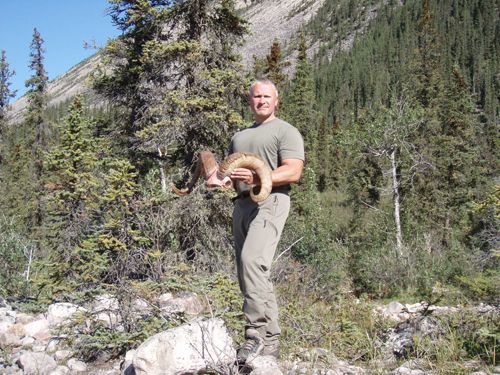 Pika (rock rabbit) not far from camp 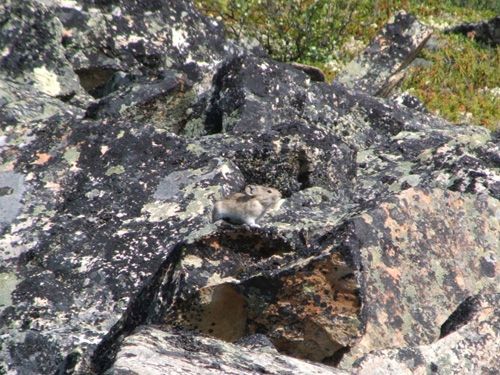 Horses coming back to camp in the morning after feeding 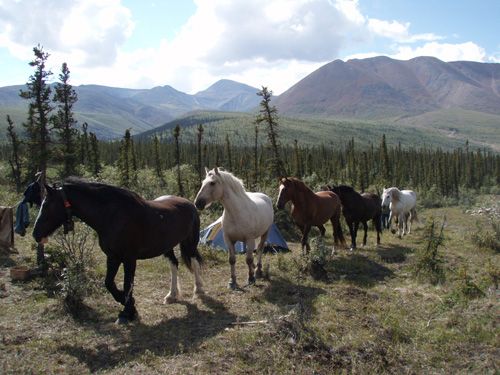 Both Chance and I were after a mountain caribou, which we glassed each night from camp. The last few evenings, Chance had seen one that he really liked, and plans were made to get on him tomorrow. Needing to find "my caribou", I moved away from camp and glassed a different hillside. As luck would have it, I stumbled on what appeared to me to be a very large bull. We setup the spotting scope, and confirmed that he was a shooter. Carson got quite excited, and Timmy eagerly volunteered to get the horses and saddle them up. The problem was, it was 9pm, and once again we were running out of time. We took the horses as far as we could, and hiked the rest of the way up the soft mossy hill. We got on the bull at last light, just as he and another were heading down the hill. I took a long 450-yard shot, well, several actually. He was hit twice hard, and I finished him off after running ahead a few hundred yards. We looked at our watches - it was midnight! And just like clock-work, it started to rain! We packed him down and struggled to find the horses in the dark (although this time we had headlamps). The guys lit a fire and caped him so that the antlers would fit on the packhorse. The ride back through the pines was a thrill, as the horses were spooked (we probably should have turned off our headlamps). I am not a horse-guy, and my knee was killing me, but it was great fun. We made it back to camp around 5am, once again tired and wet - but with a supreme sense of satisfaction. Chance took his caribou later that day (day-5). While not quite as exciting, he once again made an exceptional long shot on his bull, and I was glad to be along for the ride. Mountain caribou (scored at 427 B&C) after another long night! 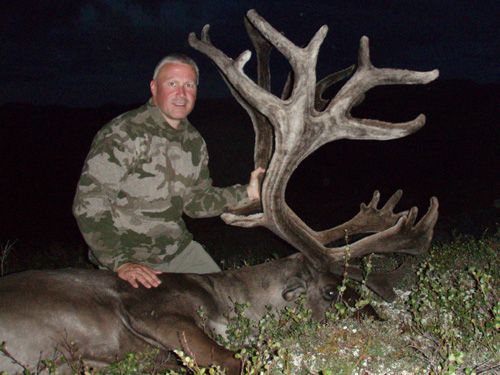 Jayme packing out the huge rack 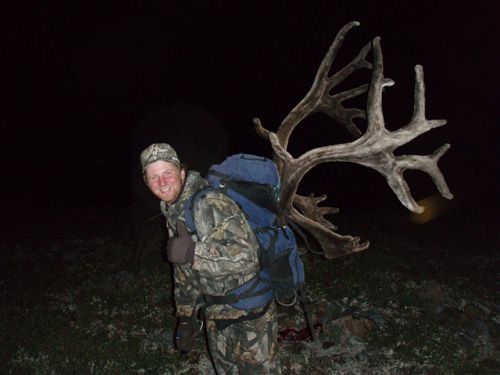 Chance with Carson and his nice old bull  Yummy caribou steaks for breakfast 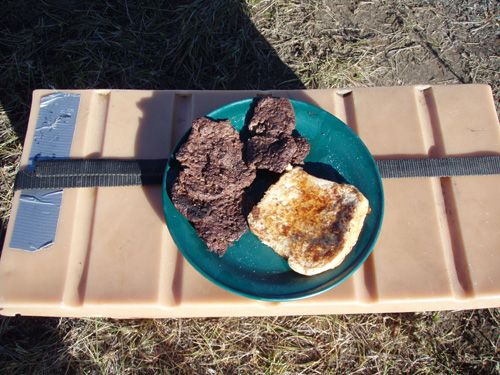 On day-7 we broke down camp and trailed back to one of the main camps. We had quite a bit of rain earlier in the hunt, but this day was glorious. My horse for the trip was "Rooster", a goofy looking horse but who's personality suited me well. I rode behind Carson, and it was my job to keep the other horses in line. Carson explained that what typically happens on one of these trail rides is that the packhorses get antsy - tangling around trees, dumping their loads, wondering off to feed, spooking, sprinting home - basically it can be a cluster-futz. Well Rooster and I took our responsibility seriously, and he'd rush to head off any rebels so I could take a swipe at their nose. But these guys are clever, having played this game for years. Whenever I'd get off to stretch my knees and lead Rooster, they would seize the opportunity. Rooster would patiently wait for me to get at least ONE foot in the stirrup before tearing off after them. This no doubt was quite amusing for the rest of the group, who was leisurely enjoying the ride behind us. At one point we had to walk the horses down a steep, rocky, muddy trail. It is intimidating being surrounded by huge, bumbling-stumbling horses, all trying to pass one another. By the time we got to the bottom, Rooster and I had fallen to the back of the line. When I got back on, I kicked Rooster a bit too hard and he took off in a flat run. I had galloped before, but the feeling of sprinting was exhilarating and amazingly smooth. The fun ended abruptly when Rooster caught the other horses and locked them up, almost throwing me over the top in the process. I am proud - and amazed - to say that despite all this and some very rugged, rocky and steep terrain, I didn't fall of my horse once! On the trail back to the main camp 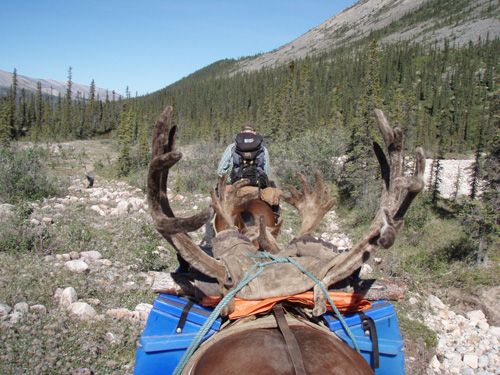 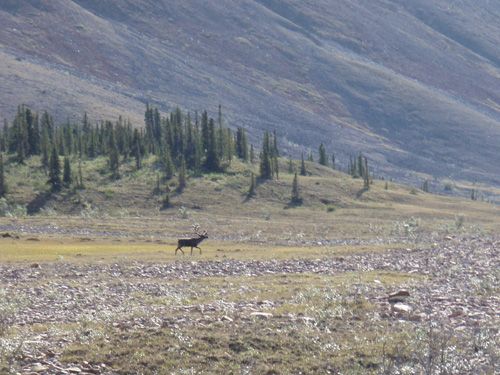 Cabin at Ram's Head Lake camp 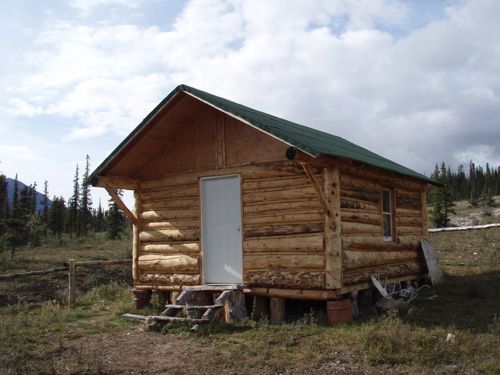 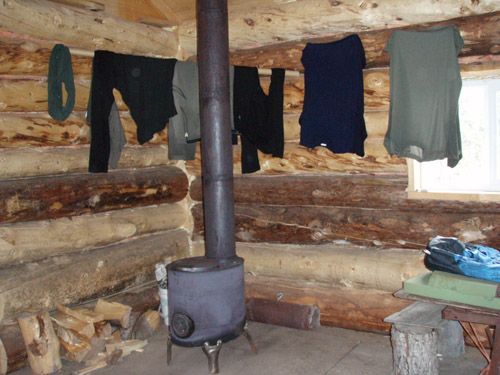 Instead of going home early, I spent three wonderful days hiking drainages around camp. Stan flew in a few more guys to help with the shoeing of the 14 horses in preparation of the long trip back to town, which left me pretty much on my own during the days. I had a rifle, wolf tag, Clif bars and a satellite phone - so I was all set. Naturally it rained every day, but this just added to the ambience and enjoyment. Each evening we would gather in the main cabin, where Meghan would cook a huge meal, fresh breads, and delicious deserts. Despite eating like a horse, I still lost 6 pounds on this hunt. It is amazing how many calories one needs to consume just to maintain body weight on a trip like this. Typical country in the NWT 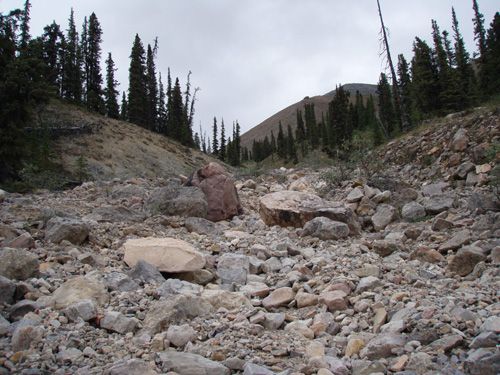 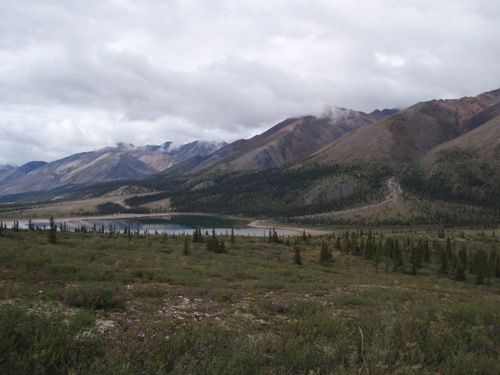 View from Stan's bush plane 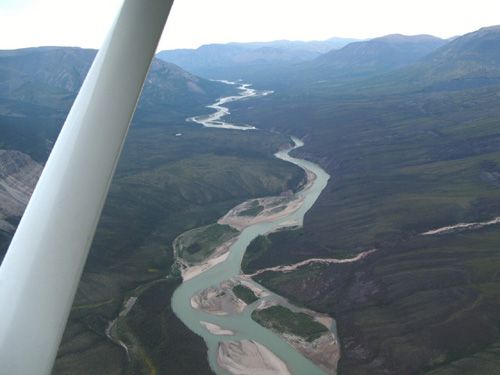 Keele River backpackers camp - river boat used to get to hunting areas 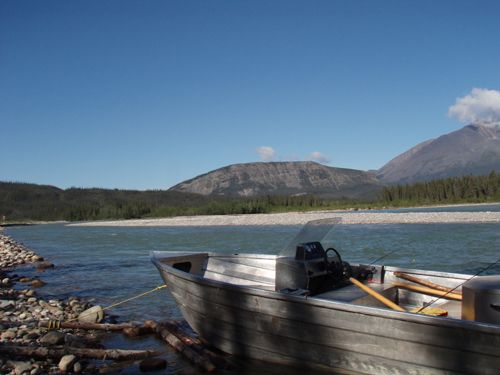 Stan picked me up the evening of day-9 in his bush plane and dropped me off at the Keele River camp. Here I spent some time with one of the backpack guides, Tyson Mackin, chatting about sheep hunting, backpacking, equipment, past hunts, etc. We hit it off, and in fact I ended up hunting "mountain mule deer" in the Canadian Rockies with Tyson two months later near his home in Alberta (CLICK HERE). Two other hunters were choppered into camp, a father and two sons from Texas and a doctor from Illinois. On my way out, I flew with Tyson and his hunter to the drop-off point for their hunt, after which Gee and I flew back to Norman Wells. The Mackenzie Valley Hotel; owner Jane below   Truck used during construction of the Canoe Trail, at the Norman Wells Historical Center 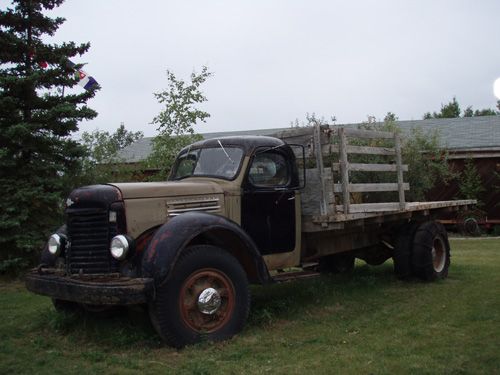 SUMMARY Although this was not exactly the hunt I was anticipating, it was an adventure and the experience exciting and memorable. This was my second trip for Dall, and I am grateful to have a dandy sheep for the wall - going home a second time without one might have turned me off of sheep hunting forever. Although not my main quarry, I am thrilled to have been able to shoot such a tremendous caribou in what turned out to be quite an adventurous hunt. I made the most of my time after the animals were down, and enjoyed hiking around the mountains on my own. Travel was long but easy, and everybody I met was great. The guides are all super and I hope to see them again. Meghan is terrific, and perhaps one day she will take over for Dad. Chance and I had an excellent time and communicate on a regular basis - I could not have asked for a finer hunting buddy. As it stands, I have "been bitten", and plan to chase Dall sheep again, on a true backpack hunt. BOOTS & FOOTCARE While few of us can exactly replicate the hills, rocks, bogs, willows, stream crossings, sun, rain, snow, etc. likely to be encountered on a typical day in the mountains – it is imperative to spend a lot of time with your primary gear, in as close to actual conditions as feasible. This is especially valuable to the first-time sheep hunter, and/or those who are planning on backpacking for some or all of the hunt, as there is little margin for error. One of the challenges that I had to overcome was in regards to boot fit. Specifically, thanks to flat feet and narrow heels, I was yet to have a pair of boots that did not cause blisters. After considerable research, I ordered a few pair of boots via the Internet with the knowledge that whatever didn’t fit I could send back. This turned out to be very convenient, as I could wear the boots in the house for a day or with different socks and footbeds, and get a much better idea of fit then in a store. Web stores such as rei.com and shoebuy.com anticipate a high degree of returns. I selected the Lowa Tibet GTX boots, which is the slightly shorter version of their popular Sheephunter boot. Each quality manufacturer offers a different fit, and Lowa's fit those with a narrow heel and average foot width quite well. They offer adequate room in the toe box, and despite the rubber rand they do stretch and mould to your feet. I absolutely love these boots. The Gore-Tex liner keeps my feet dry, yet the boots breath well and even when training in 80-90+ degree weather, sweating was not an issue. As with any good backpacking boot, out-of-box flex is modest, but they do break-in. The Tibet's worked as great on the trails as they did in the rocks, and I have yet to experience a turned ankle despite some very challenging conditions. Proper fit is key and one needs to spend some time finding the right boots, but here are a couple of helpful guidelines: (1) try the boots on later at night as your feet swell; (2) With the laces open and your toes up tight against the front of the boot, there should be about an inch between your heel and the back of the boot, leather boots will widen slightly but they won't lengthen; (3) A very little bit of up/down movement in the heel when you walk is okay, but anything excessive will cause blisters especially when climbing with a pack, and; (4) Fit can be fine-tuned by sock selection and heel shims, and/or footbeds some of which require a 1/2 larger size to accommodate. Regarding insoles, I didn't use any, opting instead to just place an extra heel shim under the Lowa footbed. I tried the Superfeet Synergizer Green Insoles as suggested for Gore-Tex boots, but there was not adequate room in the boot for a comfortable fit, and the Low Volume Black version is not recommended for Gore-Tex boots. I use Smartwool socks without liners - they wear well, dry quickly, do not retain odor, resist stretching, stay up, and minimize friction as compared to other socks that I tried. The theory with liner socks is that they will stay tight against your feet and any movement will be between the liner and the outer sock. My experience is that this friction is transferred to the foot, and that the liner does indeed move and bunch-up. Others swear by liner socks, so try both and see what works for you. Break-in of the Lowa's took a bit of effort and initially I blistered on the back of my heels plus a few hot spots. I researched the various methods to treat and more importantly - prevent blisters. A common novice suggestion was to use Duct Tape over known problem areas, which proved to be a bad idea. While perhaps good in a pinch and/or in moderation, Duct Tape is plastic and does not breathe, so heat builds up and this can cause big problems. A much better solution is a cloth tape such as "Elastikin" by J&J, or the pads that come with Spenco's Blister Kit. To help the tape/pad adhere, clean the area with an alcohol pad, and apply Tincture of Benzoin before taping. TofB is available at drug stores, ask the pharmacist as it might be behind the counter. It is an alcohol-based plant product that protects and dries the skin, and provides a sticky surface for tape to adhere to. But be careful, it forms a very strong bond that lasts for days, and it will pull skin off, especially if put over an existing blister. In this case, carefully drain and trim the blister, create a moleskin "donut", and tape mole skin turned upside down to fit the blister and help relieve pressure. For extreme blister care, it is written that TofB can be put directly on an open blister to "seal" it and form a protective coating, although it is said to cause intense pain. For more casual blister prevention and care, Band-Aid "Advanced Healing Blister Block" and "Advanced Healing Blister Cushions" worked well and the adhesive was better then the 2nd Skin product that I tried. As with the Elastikin tape mentioned above, one may need to search the Internet and order these somewhat unique products from a medical supply store. The important thing is to break your boots in ahead of time, identify any problem areas, and prepare and know how to use a blister kit based on YOUR individual needs and changing variables. Thankfully, my boots broke in nicely and my feet seemed to change in texture so that after 6-weeks or so all of this became unnecessary. However, during the hunt and on training walks I often continue to use a product called "Blister Shield", available at campmor.com. It is a silicone roll-on that reduces friction but is cleaner then powders or messy creams. OTHER EQUIPMENT There is a lot of excellent synthetic, high-tech clothing on available today, with some companies producing "mountaineering clothes" for hunting. A first-time sheep hunter needs to spend a good amount of time researching and experimenting with clothing applicable to their hunt. And this is one of the difficulties encountered, as in terms of weather, no two hunts are the same. One needs to understand that every piece of equipment is a compromise. While a particular article of clothing may be perfect one day out of three, or several hours out of a day, the rest of the time it is likely to either be too hot, not warm enough, to noisy, too bulky to pack, etc. Most every piece of equipment involves some sort of compromise. Anybody who has talked with Stan knows that he is very personable and easy-going, but quiet, and getting specific suggestions regarding equipment and such takes some work. Particular to my hunt in August, I did not need extreme weather clothing. Rain was of course to be expected, as were hot sunny days in the 70’s. Layering is key, and for this I brought along light-weight Smartwool tops and bottoms. They breath well, dry quickly, and weigh mere ounces. Anticipating the need to pack all gear in, my primary pants were an all-purpose mountain pants from REI, made with a durable, water-repellent, quick-drying, stretch fabric. Freedom of movement is an area where typical camo hunting or hiking pants is just not adequate. A popular brand with sheep hunters in Alaska is SportHill made with 3SP fabric, and these would be worth a try. During the days a short-sleeve Columbia synthetic t-shirt was adequate, but when temperatures dipped my Cabelas Micro Fleece Mock-T was warm and comfortable. At night, it also functioned as a pillow over my sleeping bag stuff sack. As an extra layer instead of the fleece top, or in addition to, I used a Cabelas MT050 Quiet Pack Jacket. Having worn Helly Hansen in the Wrangell Mtns, the MT050 was a pleasure to wear and breathable. It also worked amazingly well in heavy downpours, although if/when I visit SE Alaska again I will still consider the HH essential. A lightweight vest would have been nice while glassing. The only piece of clothing that did not work for me was my Cabelas ultra-packable rain pants. I tried the MT050 pants, but their fit was odd, and there was zero stretch in the knees which would have make climbing very difficult. I opted for Cabelas Rain Suede ultra-packable pants. The fit was great, they repelled water well, but the willows shredded them the first time up the mountain. Typical of sheephunters, I spent a tremendous amount of time researching equipment, including my backpack. As this was a guided hunt and total weights were not expected to be too great, I looked at internal frame packs only. There is mind-numbing selection of general packs available, but based on my experience of lugging around my .300 Win Mag in Alaska, I wanted something that would easily accommodate my rifle. The Eberlestock JustOne backpack fit the bill perfectly, and like the Lowa's, proved to be a perfect choice for me. Although the pack is a bit heavy at ~7.5lbs, it is well thought out, durable, waterproof, and with some practice is very user-friendly. The rifle slips into an integral scabbard and is held securely and close to your back, yet can be quickly reached in an emergency. I purchased the Spike Camp Duffle, which zips in to increase storage. This allows one to pack in additional gear and food, and pack out meat/trophies using the clever mesh compartment. The rain cover was not necessary and the contents stayed dry, although it did get a bit heavier than if covered (noting all electronic equipment, toilet paper, etc was in ZipLocks). One last "feature" is the ability to use the pack as your carry-on bag. The waist belt is removable, and the scabbard can be tucked up into the pack, creating a compact package that when filled with some essential gear (but not over-stuffed), fits perfectly into the reduced-size overhead luggage compartments. I recommend the JustOne pack without reservation. Other essential gear that worked great was a Cat’s Meow sleeping bag on top of a Therm-a-Rest ProLite 4 pad. The outfitter provided the tent, which was a Quest and included a mesh liner to prevent condensation. I trained extensively with a single Black Diamond hiking pole, but used it very little in the mountains. I quickly found it to be a hindrance in the soft moss, pines and willows. In the rocks, I was better off keeping my balance without usage of the staff, and instead focusing on placement of my feet versus also needing to place the pole. Perhaps in a different environment, and/or if I was hunting at my own pace, I would have found the staff useful. RIFLE & AMMUNITION Two months before the trip I decided to purchase a "proper" sheep rifle, with the realization that my big .300Mag Model 70 would be a burden in the mountains. I would have loved one of Mark Banschner's Sheep Hunter X-Treme rifles, especially as his shop is just a few miles from my house. However, my budget just did not permit such a purchase. After considering all the popular, light-weight and ready-to-go rifles in the sub-$1200 category, I settled on the Kimber 8400 Montana in .270 WSM. Including my faithful Swarovski 3-10x42, light-weight Tally mounts/rings, and three rounds of Federal's 140gr Accubond ammunition, the total package weighed just under 7.5lbs. I should mention that although the Kevlar stock on the Kimber Montana is light and easy to grip - but unlike a plastic stock it does nick and my stock had numerous "whitish" scars from the rocks. Not a complaint, just something to consider. Note that after the hunt, Kimber replaced my stock, which had a hairline crack in the notch where the bolt rests, total turn-around time just 5-days. EQUIPMENT SUMMARY Rifle: Kimber 8400 Montana, (270WSM); Swarovski 3-10x42; Talley Lightweight Mounts Footwear: Lowa Tibet GTX Sheephunters & Smartwool Medium Hikers Rain Gear: Cabelas MT050 Quiet Pack Jacket & Rain Suede Ultra-Packable Pants (tore) Backpack: Eberlestock JustOne J105 Sleeping: North Face Cat’s Meow + Therm-a-Rest ProLite 4 w/Stuff Sack Hiking Pole: Black Diamond Contour Binoculars: Pentax DCF WP10x42 Waterproof Camera: Olympus Stylus 720 (water/shockproof, ~6oz) PLEASE SEE ADDITIONAL PICTURES BELOW - ADDED 9/2014 | ||
|
| One of Us |
Congrats on your 'bou and sheep. Great report..love the pics. Sounds like an awesome trip! | |||
|
| One of Us |
This report has to be, without a doubt, the most thorough on AR, and even surpasses your normal high standards. Congratulations Bill! This hunt truly looks like one you will always remember and cherish for many years to come. Thank you Bill for all of the effort you obviously put into this report and giving us all a very good insight into this demanding hunt. | |||
|
One of Us |
Bill, we are all lucky that you share your well done homework with us...Oh yea, nice animals, no super trophies.. Mike | |||
|
| One of Us |
Thanks Bill for the great report, I was getting worried that you may not get'round to posting a report! | |||
|
One of Us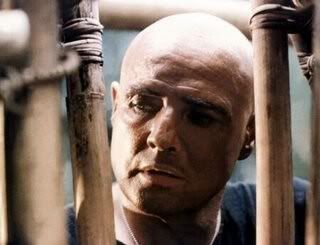 |
Thank you very much for this report which includes picts. Your report approches art, both in content and composition. I am savoring every bit of it. I have read attentively and absorbed the picts up to the end of the sheep hunt. Caribou next. One leg at a time, I guess. I read this as a break between whitetail hunting morning and evening and caping and tanning (taxidermy) bear and deer midday. I must thank you again. Also you mentioned that at one point the sheep were scared off for some reason. At that time did they see Meghan's white hat happily bobing along a mile and a half away. It is the first thing I pick up in the pictures she is in. And althouth I still have good eyesite for the oposite sex, I think it is her hat that draws me to her. It stick out from the backgrounds. And although I have not read the caribou hunt yet, did you get your velvet home intact? Awesome! Exit31 Why shall there not be patient confidence in the ultimate justice of the people? Is there any better or equal hope in the world? Abraham Lincoln | |||
|
| new member |
Bill, This is an excellent hunt report. I am going on this exact hunt with Stan in Aug. of 2007. I had been doing a pretty good job of staying calm but now I am fired up again after reading your report. | |||
|
| one of us |
Bill, great hunt and excellent report.Congratulations! mario | |||
|
| one of us |
Bill, great hunt! excellent report! Congratulations mario | |||
|
| one of us |
Thanks guys! Exit31, not sure what spooked them, we were stationary at the time, and being Dall sheep they should not be alarmed by white objects. We did not spook them on the long stalk either, which frankly amazes me. I was glassing the lead sheep at the time, and he seemed to look straight at me/us. Maybe just one of those crazy and unpredictable things that sheep do... Good question reg the antlers, this is an issue as starting last season, the airlines will no longer take the trophies (specifically caribou/moose antlers) as checked baggage. Stan works with a friend and taxidermist in Montana who properly imports the trophies into the States, then ships them out either via truck or UPS. Truck rates are low thanks to a special discount available to the Montana taxidermists. I had mine shipped w/o being split (in case I want to score it), and the cost was ~$500 total for F&W fees, allocation for transport in his semi w/the other trophies, crate building (T&M), and the shipping. I read where another AR member paid $900 to get theirs home, so Stan has a pretty good system here. However, it does make one think harder about adding a caribou to a sheep hunt. According to my taxidermist, the velvet seemed to have arrived in "good" shape, surviving the packing out, the trip from the NWT to Alberta then to Montana, and finally home to PA. I want to try to mount them w/the velvet, versus staining or getting the imitation stuff, mostly because the velvet that is on them has such unique coloration. We'll see, and I will take a look myself next time I am at his shop. I brought my two capes and sheep horns back with me, which was great. I took along a thick plastic duffle which I used as an extra bag for the capes. The great gal at Canadian North let me slide with a smile, and Air Canada charged me just $50. 9/14/2014 UPDATE - ADDITIONAL PICTURES ADDED  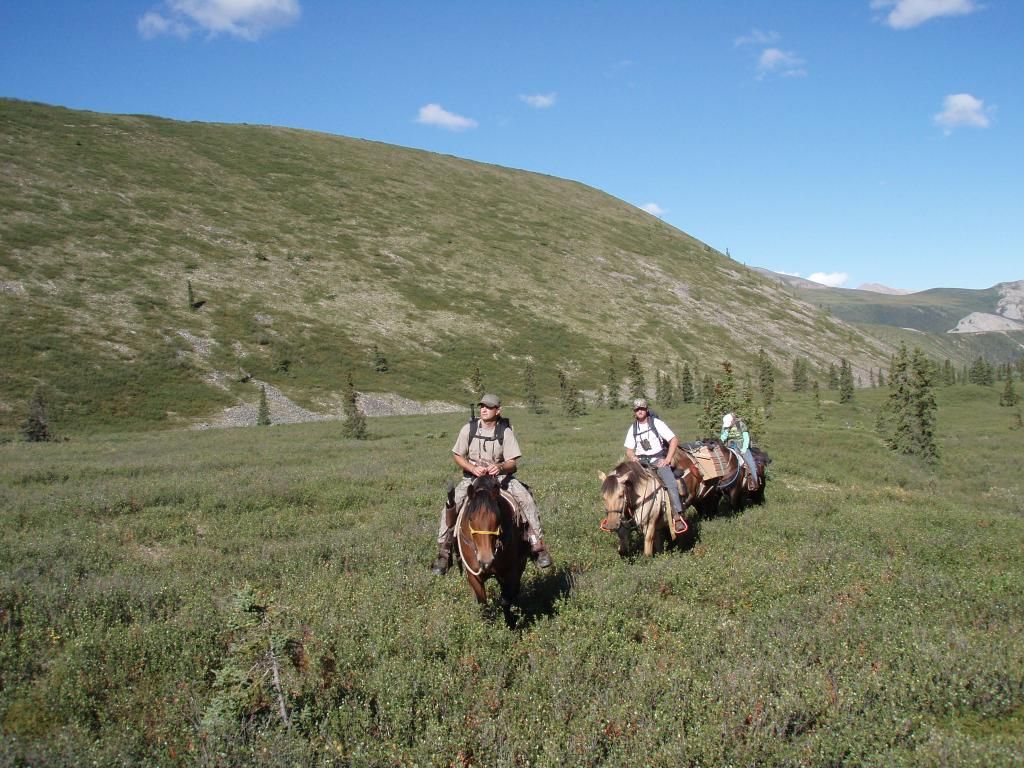 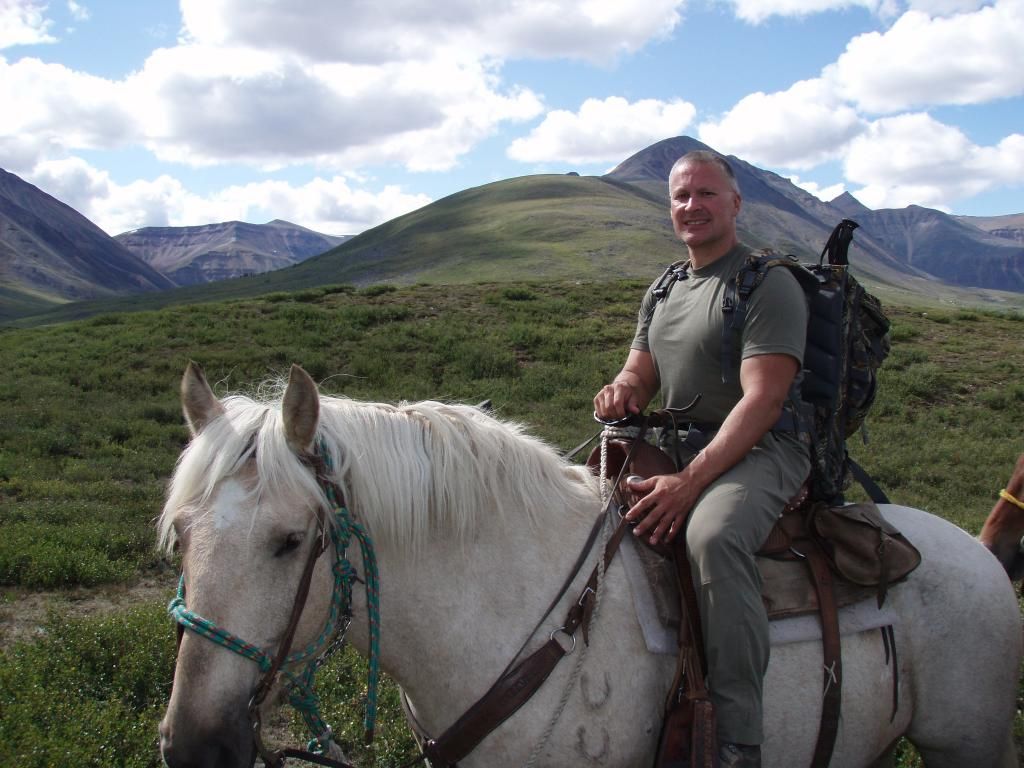   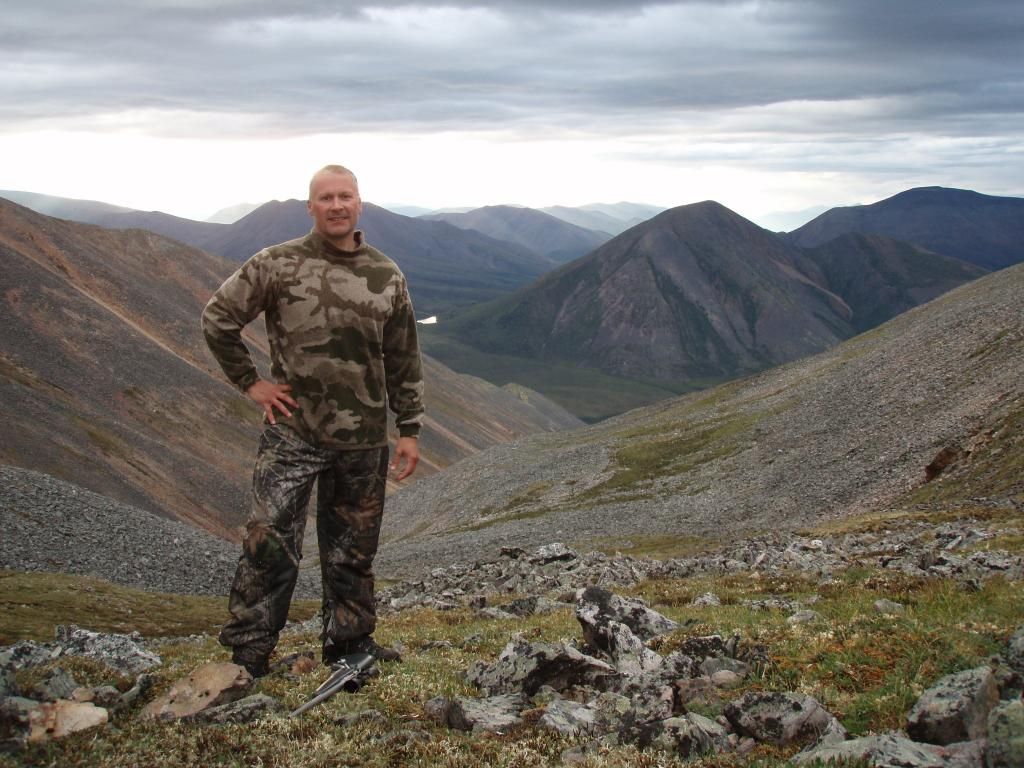 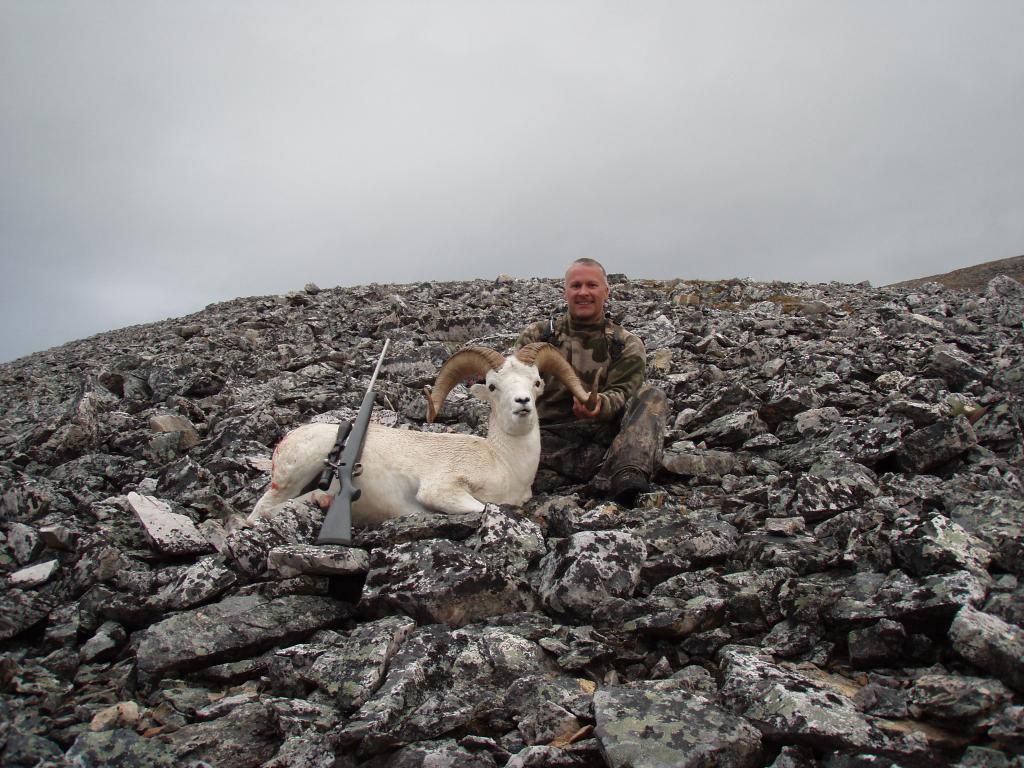  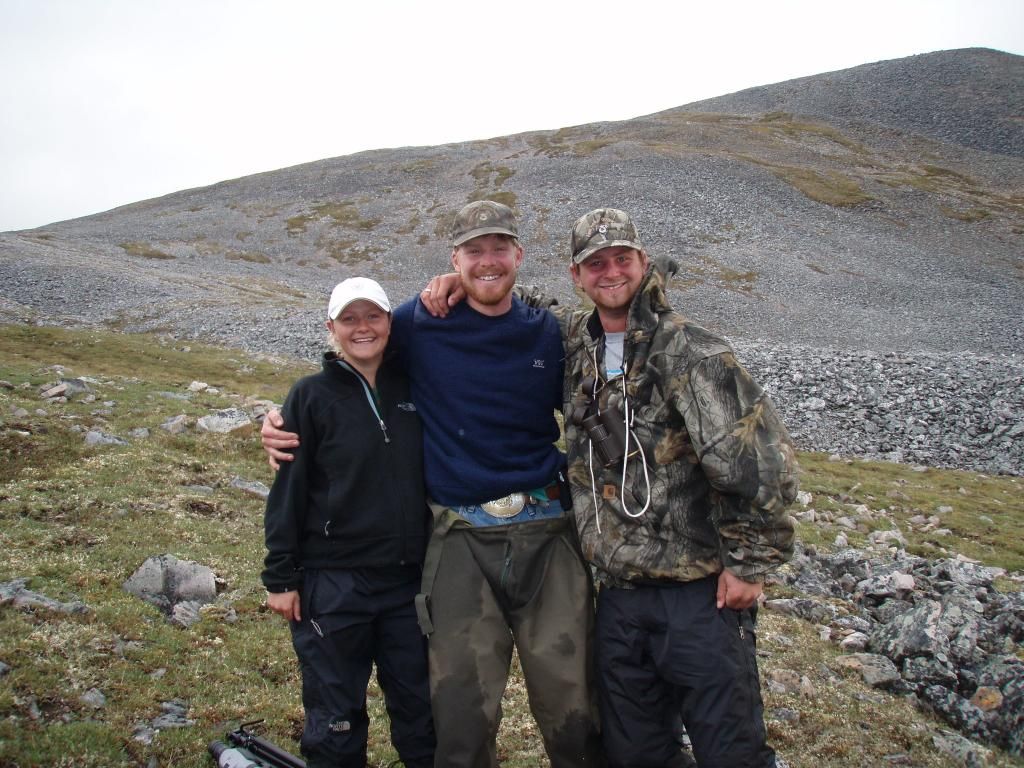 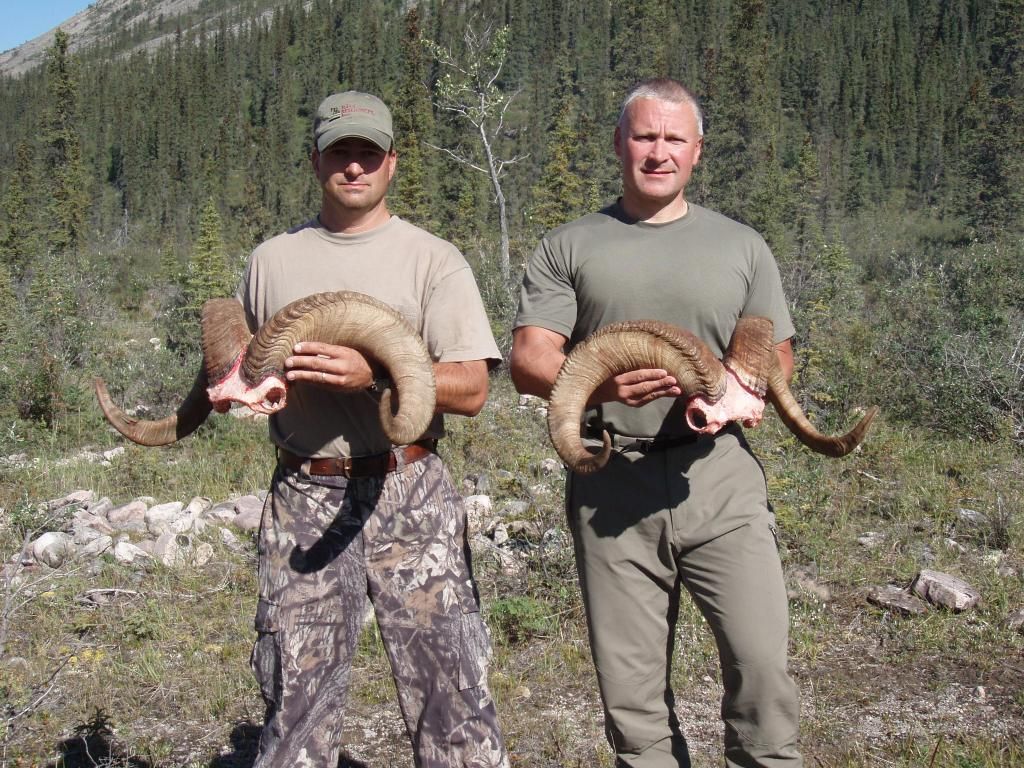 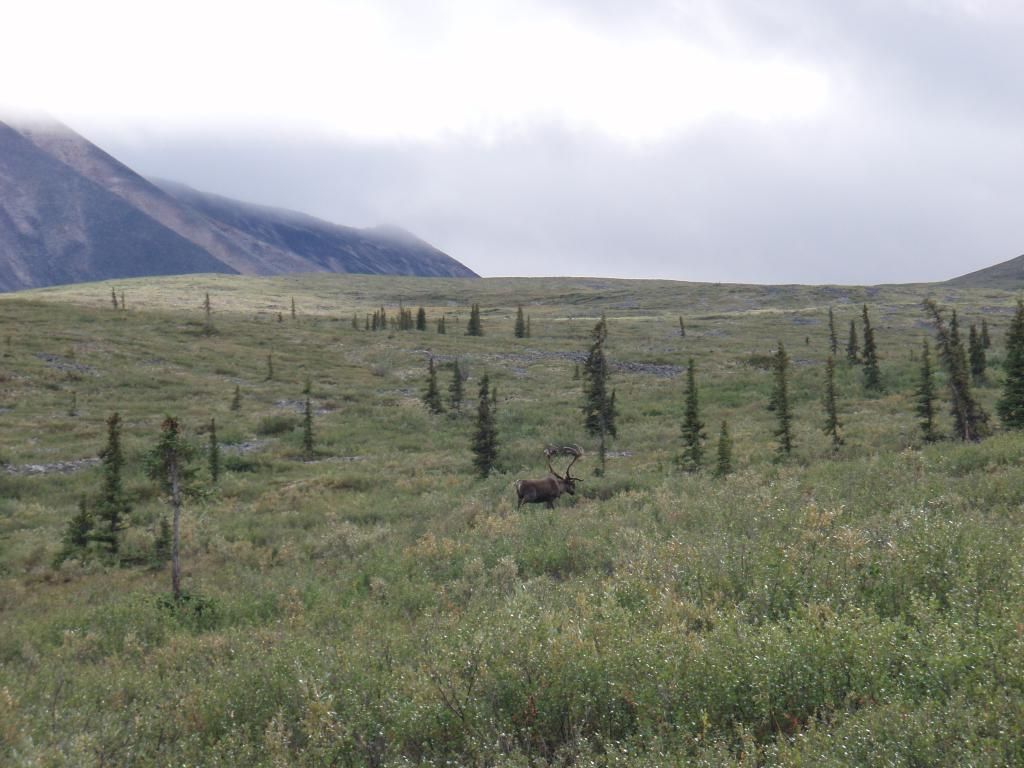 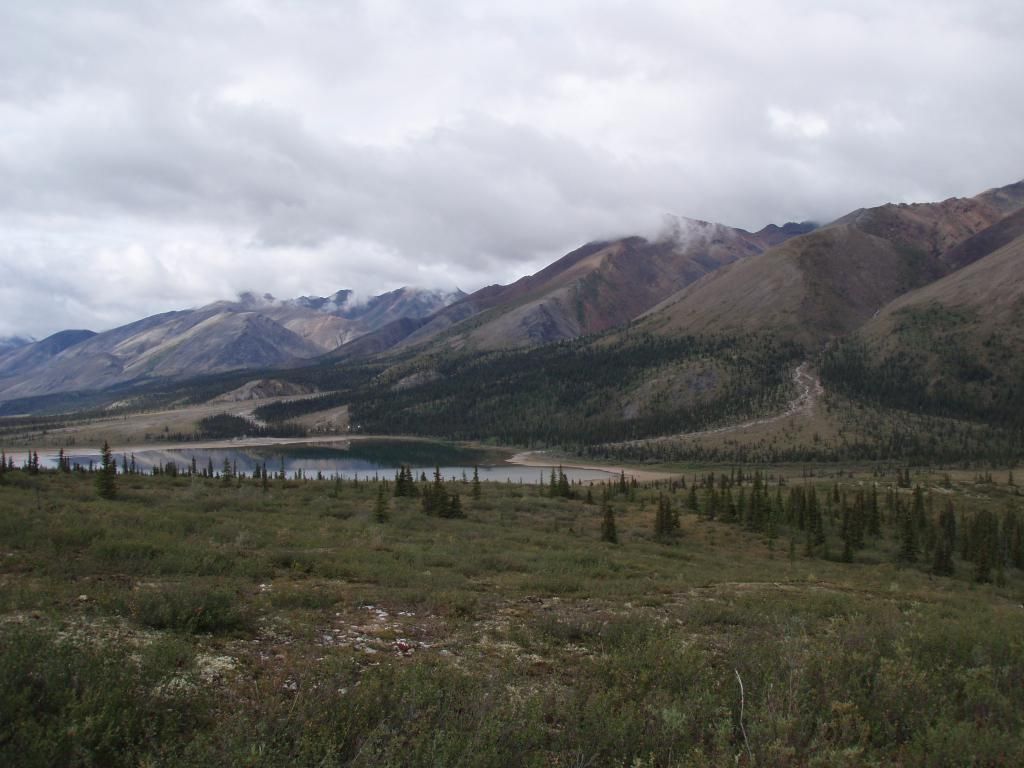 | |||
|
| one of us |
Terrific hunt and report. Congratulations. ALLEN W. JOHNSON - DRSS Into my heart on air that kills From yon far country blows: What are those blue remembered hills, What spires, what farms are those? That is the land of lost content, I see it shining plain, The happy highways where I went And cannot come again. A. E. Housman | |||
|
| one of us |
Bill, As I expected a great report with all the details. Congrats on the sheep and monster caribou. Mark MARK H. YOUNG MARK'S EXCLUSIVE ADVENTURES 7094 Oakleigh Dr. Las Vegas, NV 89110 Office 702-848-1693 Cell, Whats App, Signal 307-250-1156 PREFERRED E-mail markttc@msn.com Website: myexclusiveadventures.com Skype: markhyhunter Check us out on https://www.facebook.com/pages...ures/627027353990716 | |||
|
| One of Us |
| |||
|
| One of Us |
Bill, I always enjoy your excellent, detailed reports, and the pictures reallyh bring it all together. Big thanks for letting some of us tag along beside you, as it were, and get a real look at some of the adventures you've been on. A real inspiration you are. Now I've just got to see about finding a better paying job! Cheers, KG ______________________ Hunting: I'd kill to participate. | |||
|
| new member |
This is, without a doubt, the best example of a hunting report i have ever read. In my life. Ever!! Congrats on a fine hunt and a fantastic report. A handgun is better than a hand. | |||
|
| one of us |
Bill, a very deserved "well done" for this report. Pictures look pretty familiar! | |||
|
| one of us |
Bill, I can't believe Stan still has the green pickup truck. I thought that thing was on its last legs back in 2001. My father and I hunted with Stan back then and he got a nice ram and caribou, and I got a decent caribou also. Congratulations on the hunt. Mink and Wall Tents don't go together. Especially when you are sleeping in the Wall Tent. DRSS .470 & .500 | |||
|
| one of us |
Bill, my most sincere congratulations on a fantastic, true hynting adventure!! and what a report!! ------------------------------------------------------------------------ ColdBore 1.0 - the ballistics/reloading software solution http://www.patagoniaballistics.com | |||
|
| One of Us |
Awesome story, thank you for sharing. How much does a hunt like this cost? | |||
|
| one of us |
SkyJacker - Core costs are listed at the top of the report. In addition, there are the tips and commercial airfare. The flight from Edmonton to Norman Wells via Canadian North is considerable at/around ~$1000USD w/taxes and fees. And there is the specialized gear cost, depending on what you have and need to purchase. So while not inexpensive for a single-species hunt, Dall sheep even in the NWT (versus Yukon or Alaska) is still around $10K "cheaper" then Stone in BC or Bighorn in Alberta. Otherwise, there is Ibex in Mongolia or a Mtn Goat hunt in BC, both of which are less costly and said can offer a similar experience. Regards, Bill | |||
|
| Moderator |
That caribou is sure a monster! Color me green...thats a caribou of a lifetime. Thanks for the great report! The downside of this is that I am now less inclined to do hunting reports...lest mine be compared to yours!!! But keep it up! I have read this one three times at least now! Cheers, Canuck | |||
|
| one of us |
Thanks Canuck! But I am still fixated on your incredible Stone Sheep. If anybody has not seen Canuck's Stone, check this out: http://www.accuratereloading.com/ssheep.jpg I think my friend Mike was not being sarcastic...meant to read "nice animals - no - make that super trophies". Or he was drunk again. Anyway, the reality is that the sheep was slightly below average (size & age) for the area and given all the training I could have done better, but because there was two of us hunting together, understandably the guide's main focus was on getting two sheep (a twofer!). I am pleased and he will make a terrific mount meaning more to me then most of the dead-heads on the wall. And I still have "the big one" to look forward to if you know what I mean. | |||
|
| Moderator |
I know exactly how that goes...comes with the territory when hunting 2x1. Don_G and I hunted 6 cape buff between us in 16 days, and shot 5....there was no opportunity to be fussy about trophy quality...you shoot when you get a good chance so that the next guy can start hunting again. What you give up in trophy selection you get back in other ways though! There are no flies on that ram of yours. I think all full curl rams are trophies and they represent a lot more than inches of horn. You generally have to earn rams....an easy ram is a rarity! I don't want to steal your spotlight or hijack your thread, but thanks for the compliments on my stone. One day I will do up a hunt story/report (vague on location though!!!! Cheers, Canuck | |||
|
| one of us |
the ram cost too much money.I should of sneaked a rifle in my backpack when i backpacked Kluane,and canoed the Nahanni.I would of had the hunt of my life and no one would of suspected a colledge student. | |||
|
| One of Us |
| |||
|
| one of us |
Bill, I believe you posted another hunt report within the last year or so, Africa IIRC; I just wish they were a little more detailed! Regards, Craig Nolan Best Regards, Craig Nolan | |||
|
One of Us |
Fantastic trip. Excellent report and pictures regards Dan | |||
|
One of Us |
Good job! -eric " . . . a gun is better worn and with bloom off---So is a saddle---People too by God." -EH | |||
|
| one of us |
Bill, You have hunted so different species, enviorments, countries, etc that I just hope you have already started to write a book with your hunting experiences. As usuall, this new hunting report is excellent. Which will be the next place you will like to hunt ? Thanks for sharing L | |||
|
| one of us |
Have you ever hunted Lord Derby eland? That is one of my favourites dreams.... L | |||
|
| One of Us |
That was by far one of the best hunting storys I have ever read. and you are the kind of hunter guides dream about. The Brooks range here in Alaska looks alot like were you were in the NWT. Thanks for the report | |||
|
| One of Us |
Great story Bill and as everyone has already pointed out, the most thorough I've come across. Congrats on the hunt and thanks for all the info. This is one I had to print to make sure I had it for the archives should I ever manage to chase Dall Sheep myself. It's off to the gym with this hunt in mind. Cheers, Dan | |||
|
| Moderator |
If anything, that's an understatement! Well said, cap. Cheers, Canuck | |||
|
| one of us |
I picked up the Dall yesterday at my taxidermist, and thought I'd share the pictures with you guys. I am so pleased with the results! The turn-around time was great thanks to the tannery expediting the tanning ($75 extra charge) and the fact that I had some "slots" pre-scheduled with my taxidermist for December. As soon as I got home from the NWT, I delivered the salted cape and horns to Wes, and asked him if at all possible could he bump one of my other pieces waiting in queue, and prioritize the sheep. 4.5 months from the date of kill to hanging on my wall - not bad! And the quality is tremendous. Next to my leopard, this is my favorite mount, and each time I look at him it will bring back memories of a challenging and rewarding hunt. I asked Wes to take pictures in his studio, and I resized and merged them together using Photoshop Elements. 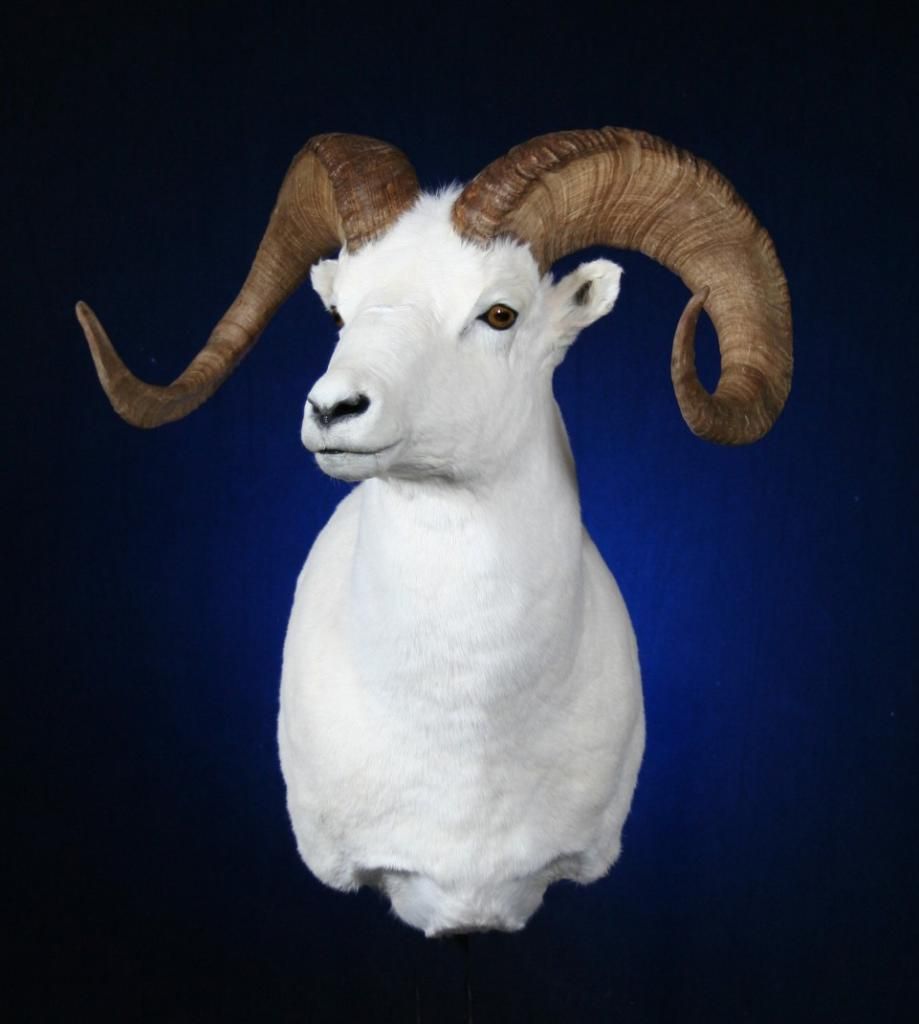 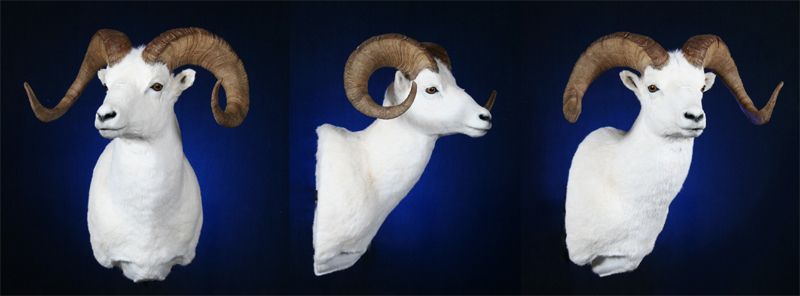 | |||
|
| Moderator |
Gorgeous mount and great pictures!! That kind of turnaround is phenomenal. My last sheep mount had me waiting for 28 months! Congrats! Cheers, Canuck | |||
|
| one of us |
You guys need different taxidermists. I shot my sheep early October and had it on the wall by Christmas.... of the same year! That said, last year's spring bear skins aren't even back from his tanner yet, so.... Yes, Canuck, we need that report on the stone, and don't be skimpy on the details! Nice mount, Bill, great photographs too! Did you make those? They look like they were made in a studio... Frans | |||
|
| One of Us |
Outstanding report Bill. Congrats on two great trophies! LDK Gray Ghost Hunting Safaris http://grayghostsafaris.com Phone: 615-860-4333 Email: hunts@grayghostsafaris.com NRA Benefactor DSC Professional Member SCI Member RMEF Life Member NWTF Guardian Life Sponsor NAHC Life Member Rowland Ward - SCI Scorer Took the wife the Eastern Cape for her first hunt: http://forums.accuratereloadin...6321043/m/6881000262 Hunting in the Stormberg, Winterberg and Hankey Mountains of the Eastern Cape 2018 http://forums.accuratereloadin...6321043/m/4801073142 Hunting the Eastern Cape, RSA May 22nd - June 15th 2007 http://forums.accuratereloadin...=810104007#810104007 16 Days in Zimbabwe: Leopard, plains game, fowl and more: http://forums.accuratereloadin...=212108409#212108409 Natal: Rhino, Croc, Nyala, Bushbuck and more http://forums.accuratereloadin...6321043/m/6341092311 Recent hunt in the Eastern Cape, August 2010: Pics added http://forums.accuratereloadin...261039941#9261039941 10 days in the Stormberg Mountains http://forums.accuratereloadin...6321043/m/7781081322 Back in the Stormberg Mountains with friends: May-June 2017 http://forums.accuratereloadin...6321043/m/6001078232 "Peace is that brief glorious moment in history when everybody stands around reloading" - Thomas Jefferson Every morning the Zebra wakes up knowing it must outrun the fastest Lion if it wants to stay alive. Every morning the Lion wakes up knowing it must outrun the slowest Zebra or it will starve. It makes no difference if you are a Zebra or a Lion; when the Sun comes up in Africa, you must wake up running...... "If you're being chased by a Lion, you don't have to be faster than the Lion, you just have to be faster than the person next to you." | |||
|
| One of Us |
congratulation bill,and thankx for sharing such an beautifull way,its like an dream.regards ur 3 greatest hunts r ur first ur last and ur next | |||
|
| One of Us |
Bill, that was a wonderful hunt and report. The critters you took were old giants, true trophies. Excellent mounts, too. Thanks for sharing. I love the pict of the horses in single file. Steve "He wins the most, who honour saves. Success is not the test." Ryan "Those who vote decide nothing. Those who count the vote decide everything." Stalin Tanzania 06 Argentina08 Argentina Australia06 Argentina 07 Namibia Arnhemland10 Belize2011 Moz04 Moz 09 | |||
|
| one of us |
It has taken me a while, but I finally have my mountain caribou mount. While the early season hair is not thick, the velvet came through amazingly well. It looks great, lighter then these pictures would indicate. I cannot believe that the velvet survived the trip - backpacked from the top of a mountain to horses, a frantic night horse ride through the pines to base camp, Cub flight to main camp for storage, transport from camp to Norman Wells, Alberta, Montana then Penna. My taxidermist had to extend the neck a bit so that the huge rack would not hit the wall when hung. Because of the size, it sits pretty low on the wall. Once again, the quality is excellent and although I was not really too excited about getting this mount done, it is now one of my favorites. Now I need one wearing their winter coat! Regards, Bill  Taxidermist: Wes Good, Wildlife Studios Myerstown, Pa 717-933-4828 wes@wildlifestudios.com Website: http://www.wildlifestudios.com Tanning: Carolina Fur | |||
|
| Powered by Social Strata | Page 1 2 |
| Please Wait. Your request is being processed... |
|
 The Accurate Reloading Forums
The Accurate Reloading Forums  THE ACCURATE RELOADING.COM FORUMS
THE ACCURATE RELOADING.COM FORUMS  Hunting
Hunting  Hunting Reports - Rest Of The World
Hunting Reports - Rest Of The World  Dall's Sheep & Caribou - NWT 2006 (+ Mount Pictures)
Dall's Sheep & Caribou - NWT 2006 (+ Mount Pictures)

Visit our on-line store for AR Memorabilia

